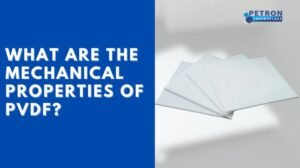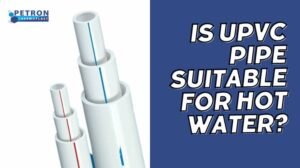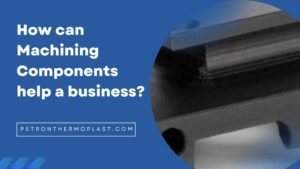Know brief information on Polyvinylidene Fluoride from Petron Thermoplast
Polyvinylidene fluoride (PVDF) is also known as polyvinylidene difluoride and PVF2. It is part of the fluoropolymers family, a group of versatile, specialized polymeric materials with distinct properties. The PVDF has a strong bond between its carbon atoms and fluorine atoms. PVDF is a special polymer with pyroelectric and piezoelectric properties. The use of this special polymer is dynamic. It manufactures high-purity, high-strength, and high-chemical-resistance products for electrical, biomedical, electronic, construction, oil and gas, fluid systems, and food industries.
Click here to know more technical page.
Petron Thermoplast, the leading thermoplastic product manufacturer in India, could guide you on how dynamic PVDF is and enrich your knowledge about its versatility.
To simplify our discussion, we divide our article into six major parts. They are:
- PVDF: what do you mean by it?
- The production procedure of PVDF.
- Common properties of PVDF.
- Prime applications of PVDF.
- How is it used in the manufacturing process?
- The current market of PVDF.
Without wasting time, let’s dive straight into our discussion.
PVDF: what do you mean by it?
PVDF is a thermoplastic, semicrystalline polymer. The degree of crystallinity of PVDF stays between 35-70%, depending on the preparation process. The unique combination of mechanical and electrical properties makes the polymer special which sets a standard of purity. It is resistant to most chemicals, including solvents, acids, and hydrocarbons.
If you look at the chemical formula, the special polymer stands between polyethylene and polytetrafluorethylene. The chemical formula of PVDF is (CH2=CF2)n. The simple chemical structure provides the flexibility of PE and some of the stereochemical constraints of PTFE. The molecular and crystal formation of PVDF change depending on the preparation of the samples.
There are five most popular crystalline forms in PVDF. They are :
- Alpha.
- Beta.
- Gamma.
- Delta.
- Epsilon.
A beta phase is a popular form where alpha and gamma constitute major phases.
The production procedure of PVDF
The chemical exports produce PVDF from free radical polymerization of the monomer vinylidene difluoride. The process occurs in a certain environment at 10 to 150 degrees centigrade temperature and a pressure of 10 to 300.
We shall discuss castings where PVDF material is processed and fabricated into parts and coatings. Some of the most popular castings are:
- Melt casting.
- Solution casting.
- Spin casting.
- Film casting.
Polyvinylidene fluoride materials go through these casting processes, and we now briefly discuss them.
Melt casting
In the melt casting process, the polymer is heated until it melts and then poured into a mold with the wanted shape until it solidifies and cools.
Solution casting
In the solution casting process, the polymer is dissolved in a proper solution to form porous polymer membranes. The polarity, molecular weight, and temperature of the solvent are prime factors in the solubility of PVDF.
Spin casting
In the spin casting process, the polymer is processed into fine films from the higher beta-phase, where films are stretched or subjected to high pressure or an electric field to develop piezoelectric fine film devices.
Film casting
The special polymer is processed into uniform, high-quality films or thin sheets in the film casting process. The process is also well known as film extrusion.
Petron Thermoplast, the leading thermoplastic product manufacturer in India, will guide you about the properties of the PVDF.
Common properties of PVDF
There are some certain characteristics of PVDF, which are the common properties of it too. They are:
- It has an excellent capability for abrasion resistance.
- The special polymers have good thermal stability.
- It can prevent ultraviolet light (UV) and high-energy radiation.
- It is a polymer with high dielectric strength.
- It has the capability of resistance to most chemicals and solvents.
- The polymer has the quality of low water absorption.
And many other properties.
Prime applications of PVDF
There are some most popular application aspects of PVDF. They are:
- PVDF components are used in filaments for quality manufacturing.
- It is used in high-purity semiconductors.
- The PVDF components used in Wire and cable isolators
- It is used in water treatment membranes.
- The PVDF components are also used in architectural coatings.
And many other useful platforms.
How is it used in the manufacturing process?
Materials with piezoelectric properties tend to extend when subjected to an electric field due to the generation of mechanical strain. The materials are important for 3D printing electronic devices, such as sensors and actuators. PVDF is a lead-free polymer, which renders it favorable in biomedical applications in the food industry. Polyvinylidene fluoride materials are flexible, a required property in applications requiring high displacement.
Polar phases’ concentration and orientation directly influence the PDAF sensors.
The current market of PVDF.
Pipes, fittings, Li-ion batteries, and semiconductors control the market for PVDF. The market of PVDF is growing at a significant rate, and it is witnessing steady growth. The countries with a large population could be the best market for PVDF products. The properties of PVDF are expected to have an impact on the market of the growing biomedical industry.
Bottom line
If you want more information on Polyvinylidene fluoride, consult with Petron Thermoplast, India’s leading thermoplastic product manufacturer.




I don’t think the title of your article matches the content lol. Just kidding, mainly because I had some doubts after reading the article.